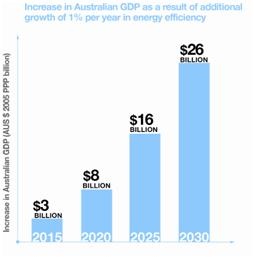How much can energy efficiency save you?
For a solution that can boost the economy, save us all money and cut carbon pollution, energy efficiency doesn’t get much air time.
For the last few years the national conversation has been dominated by debates over productivity, carbon reduction and electricity prices. Energy efficiency helps achieve our goals in all three. But from the politicians, the pundits, the business groups there’s been – well, at best silence, and at worst, pressure to cut back on the existing programs and avoid new ones.
This would only make sense if Australia’s energy use was so productive we couldn’t squeeze a single drop more value out of it.
But we are very far from that point.
Australia’s energy waste costs us billions of dollars annually and reduces economic growth. Ground-breaking new research by Vivid Economics shows that a 1 per cent increase in energy efficiency can boost GDP growth by 0.1 percentage point. That’s roughly equivalent to $1.5 billion on last year’s GDP. If you keep up that level of annual improvement, Australia would gain an extra $8 billion by 2020 and $26 billion by 2030.

Research by ClimateWorks Australia has already identified where some of the biggest opportunities lie.
The industrial sector is implementing less than half the energy savings it has identified – leaving roughly $2 billion a year on the table. We could save 37 per cent of the energy we use in commercial buildings. And if we aimed to catch up with European fuel economy standards by 2024 we could collectively avoid spending $8 billion on petrol. That’s an extra $850 for the average driver.
If we don’t get our act together, not only do we throw those benefits down the drain, we will fall further and further behind our trading partners and competitors.
Canada’s rate of energy efficiency improvement, for example, is already double Australia’s. The United States’ love of gas guzzlers rivals our own, but it has implemented ambitious efficiency standards for its vehicle fleet. And just last week the US and China agreed to work together to boost energy efficiency in their vehicle fleets, freight systems and building stock. Japan, the United Kingdom, France and South Korea are all continuing their efforts to get the most out of their energy use.
By comparison Australia has a patchwork of policies, none of which is optimised for maximum effect. It’s true that they’re working: the downward trend in electricity demand reflects (among other factors) both the success of existing energy efficiency initiatives and consumer responses to sustained rises in electricity prices over the last five years.
But these efforts are uneven and piecemeal. Much more can be done – and needs to be done – to address further prices pressures resulting from rising fuel costs, inappropriate electricity market regulation and incentives, and the need to decarbonise the country’s energy supply.
Energy efficiency can’t be improved without addressing the efficiency of our electricity system itself.
There’s now a stack of reports on the inadequacies and distortions of our current electricity market, with most targeting the way we regulate electricity networks.
If Australia had made a nationwide effort to improve energy efficiency five years ago, we wouldn’t have seen electricity bills go up 70 per cent in the last five years, because we could have avoided spending so much on poles and wires.
Now that electricity consumption has fallen, we don’t even need all the poles and wires we built – but we still have to pay for them. We can’t afford to carry on like this.
The Climate Institute is calling for a national target – an ambitious but achievable aim to raise Australia’s energy productivity by 30 per cent by 2020 (from 2010 levels). This could be done through policies such as:
-- Expanding state-based energy saving schemes into a nationally consistent and robust Energy Saving Initiative covering the whole country.
-- Implementing ambitious emissions or efficiency standards for vehicles equivalent to United States standards by 2015 and European standards by 2020.
-- Using the new national framework for regulating Minimum Energy Performance Standards (MEPS) to drive more ambitious equipment standards.
-- Pricing that more accurately reflects the true costs of energy use: time-of-use and critical peak electricity pricing; removal of fossil fuel subsidies; pricing of externalities like pollution.
-- Bipartisan support for maintaining the carbon price mechanism, which contributes to shorter payback periods for energy efficiency investments. Maintaining the carbon price also suppresses sovereign risk premiums attached to financing of investments.
Kevin Rudd’s National Press club speech last Thursday picked out electricity market reform as the first priority in a renewed competitiveness agenda. He’s not wrong – but that’s still only part of the story. We need to recognise that efficient energy use is not just about swapping light bulbs; it’s an increasingly important driver of productivity.
Tackling Australia’s energy waste won’t be easy but now’s the time for our politicians to rise to the challenge.
Olivia Kember is National Policy and Research Manager for The Climate Institute.















